Is Your Amber Real?

Is Your Amber Real? How To Identify Faux Amber From Real Amber Before we can talk about identifying real and fake amber, we have to know what amber is in the first place. Amber is fossilized tree resin, which became a fossil after millions of years. Amber can come in different colors and shades, and some even have some inclusions. My piece of amber with insect inclusions Inclusions in amber are usually referred to as different animals and insects inside the piece. If you look at the attached photo, you can make out some dark spots. Those dark spots are different small insects such as mosquitos and spiders that were trapped in the amber, and stayed preserved inside. People have found pieces of amber with animals ranging from snakes to frogs. Those pieces are extremely expensive. If you were to spend a ton on a piece of amber with an animal inclusion, you'd want it to be real, right? Identifying Real Amber From Faux Amber ...
